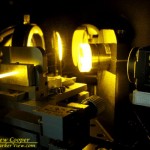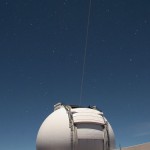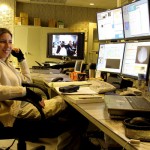Yellow light, specifically light at 589nm, the yellow glow of excited neutral sodium. A color of light familiar to anyone who has stood under the soft glow of low pressure sodium streetlights. A laser shining at 589nm, aimed high into the atmosphere, will encounter a layer of sodium atoms at an altitude of 90km (60miles). When the yellow light strikes this sodium it will excite the atoms and cause them to glow, creating a dot of light, an artificial ‘star’ in the sky.
An artificial star, a useful thing if you want to analyze the distortion caused by the atmosphere. If you can understand these distortions you can use the information to correct the images of an instrument looking though the atmosphere, creating sharp views of stars and galaxies, views vastly better than were possible before the advent of adaptive optics. Such system are now routinely used on large telescopes across the globe to allow a clear view of the universe we live in.
Adaptive optics systems are amazingly complex instruments. Hundreds of filters, lenses, mirrors and other optical surfaces interact with dozens of motorized stages and half a dozen cameras. Controlling the system are a horde of computers, some of which are specialized machines with impressive processing power. Everything must work in concert, the failure of one element can bring the whole system down.
A laser is not necessary for an operating AO system, but without it there is 70% of the sky that can not be observed, making a laser highly desirable. While the K2 AO laser has been operating for several years, Keck Observatory has never had a laser on the Keck 1 telescope.
Creating the K1 Laser has been a process of several years. Planning, designing, building, installing and testing. A lot of people have put a huge amount of effort into making the K1 Laser a reality. The job is not done yet, there are still issues and many lines left on the action item lists.
This week I have lived more on the summit than off, helping to deal with the numerous details that any complex system invariably entails. A constant list of little problems that must be solved… add a wire here… drill a new hole here to bring the fiber through… just for testing let us tap into the power diode circuit from the PLC to see the voltage.
An observation I have often made during my career… It is the electrical engineer stuck in the middle trying to coordinate the mechanical, software, optics and other disciplines needed to build a complex system. I find myself increasingly in that role, talking optics and computer code while everyone attempts to complete their part of the job. I make certain the telescope will be positioned for our work, and that the right people will be on hand when needed. I did not envision this role when getting assigned to the project, but more and more I move to the center. I am not the project manager, but I am the one on the mountain and available to answer the questions. How is it that the electrical engineer always ends up coordinating?
Thursday saw the culmination of this effort, for the first time a yellow beam shone forth from the Keck 1 telescope. It was operating at low power, and there are a few parts of the system unfinished, but it worked! A great deal of testing took place in those first few hours of operation, proving out the technology and testing the software. A few issues were found, some already fixed. But that is what an engineering night is for. In three days we go on-sky again for another engineering night, most likely finding yet more issues that need to be fixed.
To record the event I took a few photos… well… actually, a lot of photos. The laser is a dramatically photogenic image, a shaft of yellow light stabbing into the sky. The evening actually saw three lasers on the mountain as Gemini and Subaru were lasing along with Keck 1. There are now four laser assisted AO systems atop the summit, hopefully, one day soon, there will be a night with all four operating at the same time. Now that is a night for which I will have to plan some photography.
That yellow beam is a testament to all the people who have put forth so much effort to building the system. Soon this laser will begin regular operations, in the process exploring more of our universe. What images will this AO system enable? What truths of the cosmos might it help to discover? The laser may be only one part of the effort, but without it our view would be blurred and imperfect.





